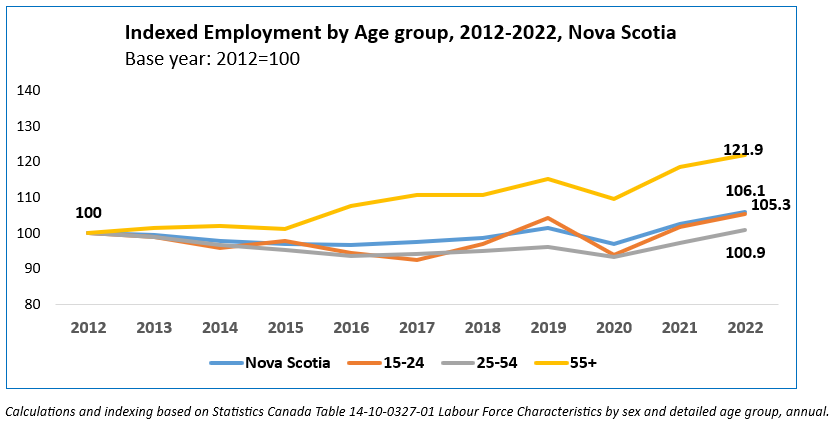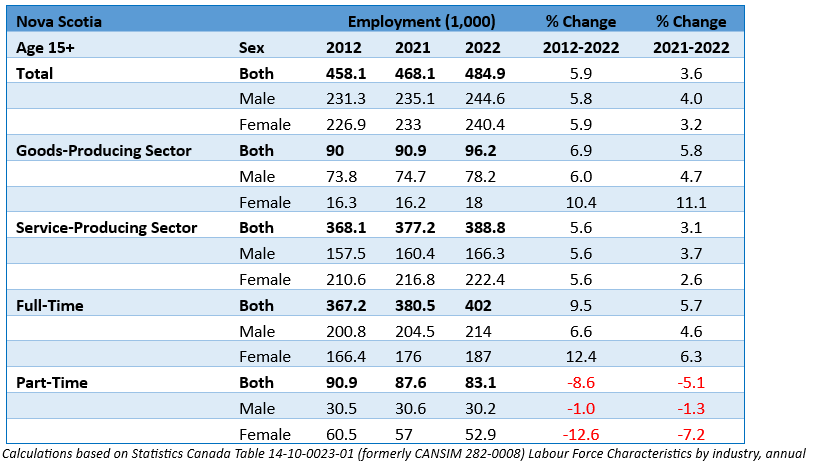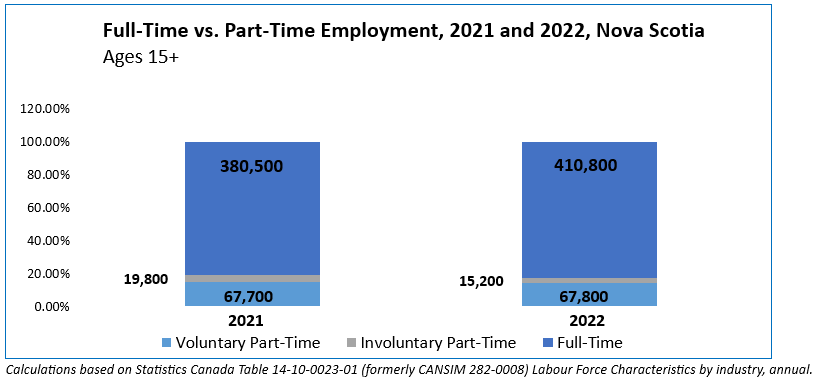Age
- Before the COVID-19 pandemic, Nova Scotia’s overall employment levels were relatively stable since 2011. From 2011 to 2019, trends in employment levels by age group were mainly driven by demographics.
- The economic shock resulting from the arrival of COVID-19 caused a -4.7% year-over-year drop in overall employment in 2020. The level of employment recovered the following year, gaining 5.4% in 2021, which continued in 2022 when employment grew by +3.6% or +16,800, compared to 2021.
- Young workers suffered the largest drop in employment in 2020 at -12.7% but rebounded the most in 2021 with a +9.8% gain. This continued in 2022 with young workers employment increase of +3.4% or + 2,200 workers.
- Core aged workers posted a 3.5% gain in employment in 2021 following a -2.7% decline in 2020. Core aged workers employment growth continued in 2022 with additional +3.7% or +10,800 employees in this age group.
- Employment among older workers fell -4.8% in 2020, before increasing by +8.2% in 2021, and then again increasing by +3.2% or +3,700 employed persons in 2022.
- In the 10 years following 2012, employment among older workers sits at +23.3% above the 2012 level, while employment among youth and core aged workers has only increased by +3.9% and +0.7% respectively.

Gender
- There were nearly as many females employed in Nova Scotia (240,400) as males (244,600) in 2022.
- There continue to be differences in the types of industries in which males and females are represented.
- In 2022, 92.5% of females and 68% of males were employed in the service-producing sector.
- Comparatively, the goods-producing sector employed 32% of males and 7.5% of females in 2022.
- There are also gender differences in the participation of males and females in part-time and full-time work. In 2022, a higher percentage of males (87.3%) were employed full-time compared to females (77.9%).
- In 2022 compared to 2021 male part-time employment was down -1.3% or -400 jobs, while female part-time employment was down -7.19% or -4,100 jobs. Male full-time employment was up by +4.65% or +9,500, while female full-time employment also went up by +6.25% pr +11,000.

Employment Type
- In 2022 employment grew by +3.6% or +16,800, which is 3.1 percentage points more than in 2021 compared to 2020.
- The service-producing sector grew +3.1%, gaining +11,600 jobs compared to 2021 and surpassing its 2019 levels. Male employment in this sector grew +3.7, or +5,900 jobs, while female employment grew by +2.6% or 5,600 jobs.
- In 2022 goods-producing sector gained +5,300 jobs, or +5.8% increase compared to 2021. Male employment in this sector grew by +4.7% or +3,500 jobs while female employment grew by +11.1% or +1,800 jobs.
- Full-time jobs accounted for 83%, while part-time jobs accounted by 17% of all jobs in Nova scotia in 2022. This is 3 percentage points higher than 10 years ago in 2012.
- Part-time employment can either be voluntary or involuntary. Someone may be voluntarily employed part-time because they are in school or have other reasons or personal preferences. Involuntary part-time is a result of being employed part-time due to business conditions or not being able to find work that offers full-time hours. The number of involuntary part-time workers decreased in 2022 by -4,600, or -23.3%. Voluntary part-time employment increased for +100 or +0.1% compared to 2021.

Document
EmploymentCharts.xlsx
(28.19 KB)